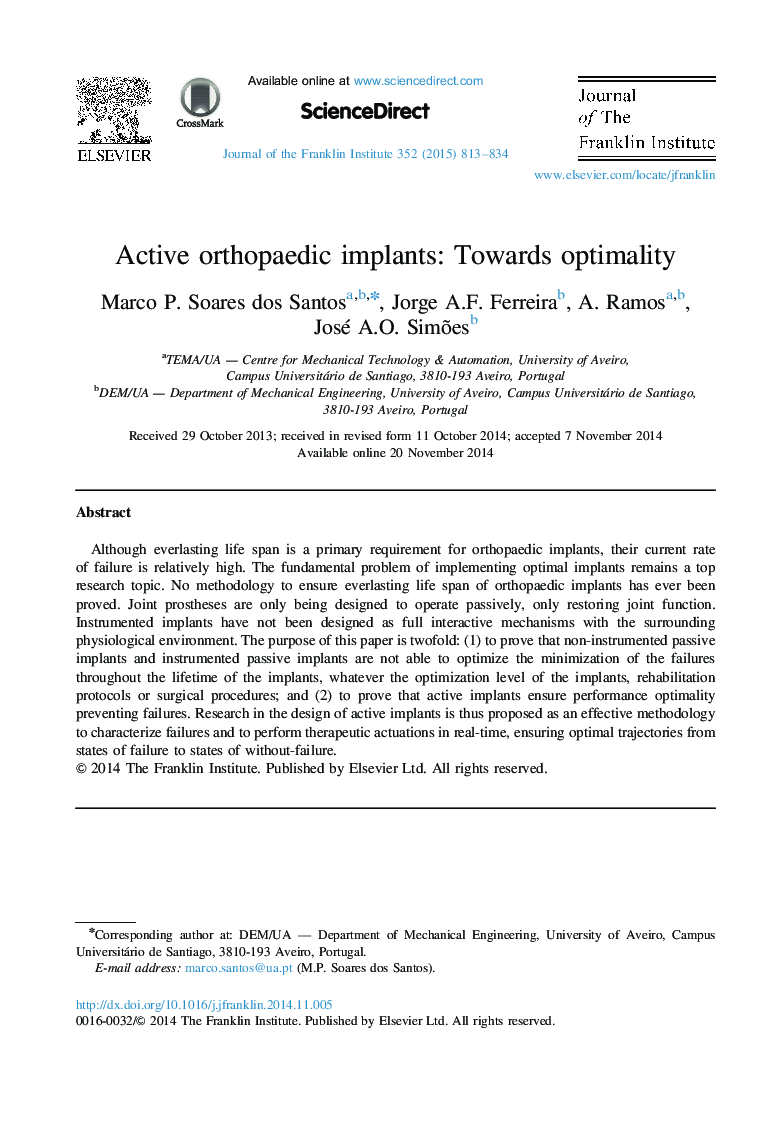| کد مقاله | کد نشریه | سال انتشار | مقاله انگلیسی | نسخه تمام متن |
|---|---|---|---|---|
| 4974558 | 1365538 | 2015 | 22 صفحه PDF | دانلود رایگان |
عنوان انگلیسی مقاله ISI
Active orthopaedic implants: Towards optimality
ترجمه فارسی عنوان
ایمپلنت های فعال ارتوپدی: به سوی بهینه سازی
دانلود مقاله + سفارش ترجمه
دانلود مقاله ISI انگلیسی
رایگان برای ایرانیان
ترجمه چکیده
اگر چه طول عمر ابری یک نیاز اولیه برای ایمپلنت های ارتوپدی است، اما میزان شکست فعلی آنها نسبتا زیاد است. مشکل اساسی در اجرای ایمپلنتهای بهینه، موضوع اصلی پژوهش است. هیچ روش شناسی برای اطمینان از عمر طول عمر ایمپلنت های ارتوپدی تا کنون ثابت نشده است. پروتز متحرک تنها به صورت غیر فعال عمل می شود، فقط بازسازی عملکرد مشترک است. ایمپلنت های مصنوعی به عنوان مکانیسم های تعاملی کامل با محیط فیزیولوژیکی اطراف طراحی نشده اند. هدف این مقاله دوگانه است: (1) اثبات اینکه ایمپلنت های غیرمستقبل غیر فعال و ایمپلنت های غیرفعال شده ابزار قادر به کمینه سازی شکست در طول عمر ایمپلنت ها نیستند، هر چه میزان بهینه سازی ایمپلنت ها، پروتکل های توانبخشی یا روش های جراحی؛ و (2) برای اثبات این که ایمپلنت های فعال اطمینان از عملکرد مطلوب را برای جلوگیری از شکست فراهم می کند. بنابراین تحقیق در طراحی ایمپلنت های فعال به عنوان یک روش موثر برای مشخص کردن شکست ها و انجام اقدامات درمانی در زمان واقعی ارائه شده است، که مسیرهای مطلوب را از حالت های شکست به حالت های بدون شکست ارائه می دهند.
موضوعات مرتبط
مهندسی و علوم پایه
مهندسی کامپیوتر
پردازش سیگنال
چکیده انگلیسی
Although everlasting life span is a primary requirement for orthopaedic implants, their current rate of failure is relatively high. The fundamental problem of implementing optimal implants remains a top research topic. No methodology to ensure everlasting life span of orthopaedic implants has ever been proved. Joint prostheses are only being designed to operate passively, only restoring joint function. Instrumented implants have not been designed as full interactive mechanisms with the surrounding physiological environment. The purpose of this paper is twofold: (1) to prove that non-instrumented passive implants and instrumented passive implants are not able to optimize the minimization of the failures throughout the lifetime of the implants, whatever the optimization level of the implants, rehabilitation protocols or surgical procedures; and (2) to prove that active implants ensure performance optimality preventing failures. Research in the design of active implants is thus proposed as an effective methodology to characterize failures and to perform therapeutic actuations in real-time, ensuring optimal trajectories from states of failure to states of without-failure.
ناشر
Database: Elsevier - ScienceDirect (ساینس دایرکت)
Journal: Journal of the Franklin Institute - Volume 352, Issue 3, March 2015, Pages 813-834
Journal: Journal of the Franklin Institute - Volume 352, Issue 3, March 2015, Pages 813-834
نویسندگان
Marco P. Soares dos Santos, Jorge A.F. Ferreira, A. Ramos, José A.O. Simões,
